

Discover the 10 best resource management software platforms — ranked by key features, pricing and more — to choose the best one for your business.
Resource management software helps businesses of all sizes track and optimize resources such as finances, personnel, equipment and materials. This can help businesses manage their operations better, improve productivity and increase profits. If you’re currently managing your resources in an Excel spreadsheet, upgrading to resource management software can take your business to the next level.
We’ve rounded up 10 of the best resource management software options and broken down their pricing plans, features pros and cons to help you make a decision.
| Software | Best for | Starting price | Capacity Planning | Resource scheduling | Integration with third-party tools | Free trial |
|---|---|---|---|---|---|---|
| Resource Guru | Affordability | $4.16 per person per, month, annually | Yes | Yes | Yes, 1,500+ | 30-day free trial |
| Mosaic | Intuitive resource management | Custom price | Yes | Yes | Yes | 30-day free trial |
| Kantata | All-in-one resource management tool | Custom price | Yes | Yes | Yes | Yes |
| Bitrix24 | Small businesses | Free | Yes | Yes | Yes | 30-day free trial |
| Hub Planner | Distributed and WFH teams | $7 per resource per month | Yes | Yes | Yes | 30-day free trial |
| Float | Agencies | $6 per user per month | Yes | Yes | Yes | 30-day free trial |
| ClickUp | Enterprise | Free | Yes | Yes | Yes, 1,000+ | Yes |
| Smartsheet | Workflow automation | Free | Yes | Yes | Yes | Yes |
| monday work management | Flexibility and customization | Free | Yes | Yes | Yes | 14-day free trial |
| Wrike | Midsize to large enterprise | Free | Yes | Yes | Yes, 400+ | 14-day free trial |
If your resource management needs mostly revolve around scheduling, then check out Resource Guru, which is designed to help with exactly that. This cloud-based resource planner software helps companies manage and schedule resources, such as not only employees but also meeting rooms, equipment and other assets (Figure A). Features include real-time reporting, calendar synchronization, time tracking via integration and customizable views. Pricing plans are also extremely affordable, starting at $4.16 per person per month.
Resource Guru is specifically focused on resource scheduling and management, and it excels at this particular goal — though it may not be robust enough for other types of effective resource management. Its pricing plans are also extremely affordable, meaning that even small businesses on a budget can try this resource tracking tool.
Mosaic is an AI-powered resource management platform that helps organizations plan, schedule and optimize resources. The visual, intuitive design and drag-and-drop interface make it easy to take advantage of the tool’s powerful features (Figure B). The resource allocation tools harness the power of AI to help you build a team with specific skill sets in just minutes. Mosaic also comes pre-loaded with reporting templates and graphs that are specifically designed for resource management needs.
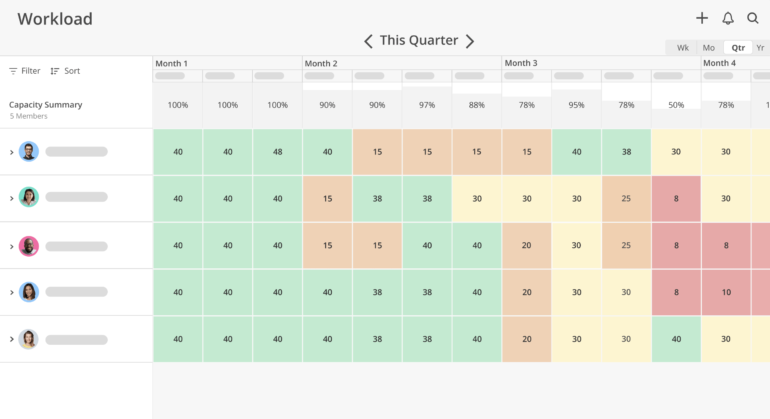
Mosaic offers three pricing plans:
However, they don’t disclose pricing information for them. You must contact the sales team for a custom pricing quote.
Mosaic also charges small monthly fees for certain add-ons:
In the resource tracking software market, Mosaic stands out for its intuitive design, drag-and-drop interface and low learning curve for beginners. It also doesn’t sacrifice functionality, packing the software full of resource-specific features that will meet many companies’ needs.
Formerly known as Mavenlink and Kimble, Kantata is a cloud-based resource tracking tool that provides professional services firms with effective resource management in addition to project management, financial management and business intelligence. Its resource management capabilities include resource forecasting and capacity planning, resource allocation and scheduling (Figure C), skills inventory and talent network management. Some specific features include project scheduling time tracking, expense management and billing and invoicing.
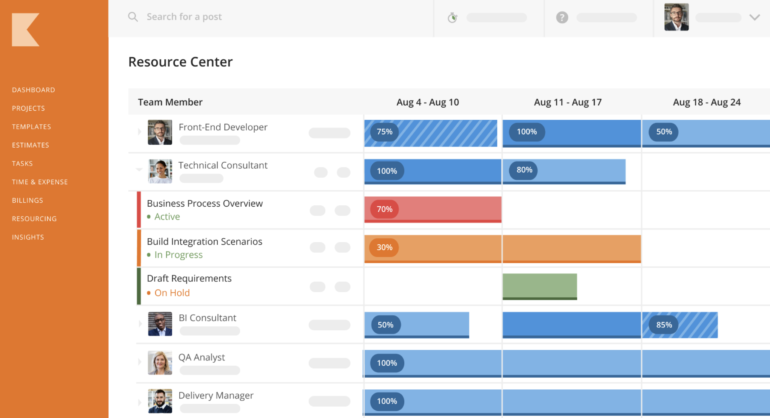
Kantata does not publicly disclose the pricing information for its software; you must contact the sales team to get a custom quote.
Kantata offers an excellent selection of resource management apps — not just project scheduling, but also resource capacity planning, resource forecasting tools, skills analysis and more. Its additional features, such as project management and financial management, make it an all-in-one tool for businesses seeking a lot of functionality.
Bitrix24 is a project and resource management software platform for businesses of all sizes. It has a unique pricing structure where it charges a flat fee for a certain number of users each month, which makes it a useful option for small businesses who don’t want to hassle with adding every single new hire. In addition to effective resource management tools (Figure D), Bitrix24 also provides a range of communication features to promote digital collaboration, including video conferencing, instant messaging and document sharing.
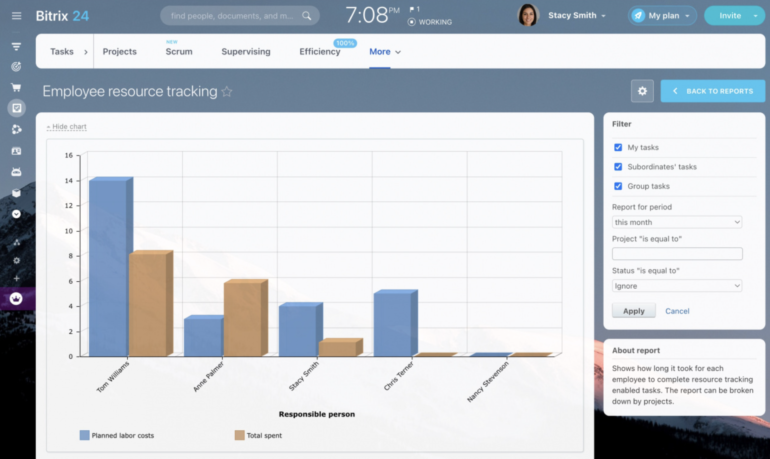
Bitrix25 comes with more than 35 tools to help small businesses optimize their work, including a CRM and resource management. Its pricing structure also takes the guesswork out and means that costs won’t be fluctuating every single month.
Hub Planner’s resource management app helps businesses manage their available resources, schedule projects and track time on one centralized platform. With Hub Planner, you can view instant availability insights and filter teams by utilization to allocate resources (Figure E). You can also track billable vs. non-billable hours and estimated time spend vs. actual time spend to use your time more efficiently in the future.

Hub Planner’s resource forecasting tools makes it an excellent choice for remote teams and distributed teams. Its enterprise-level reporting features will also be appreciated by businesses seeking to deep dive into their resource management data.
Float is a cloud-based project and resource management software designed to help teams, agencies and studios manage their projects, resources and budgets. Its colorful, visually appealing interface makes it easy to see workloads at a glance, reallocate resources as needed and create a schedule (Figure F). The budgeting and planning tools ensure that you stay within the client’s parameters, while the time tracking helps your team meet deadlines.
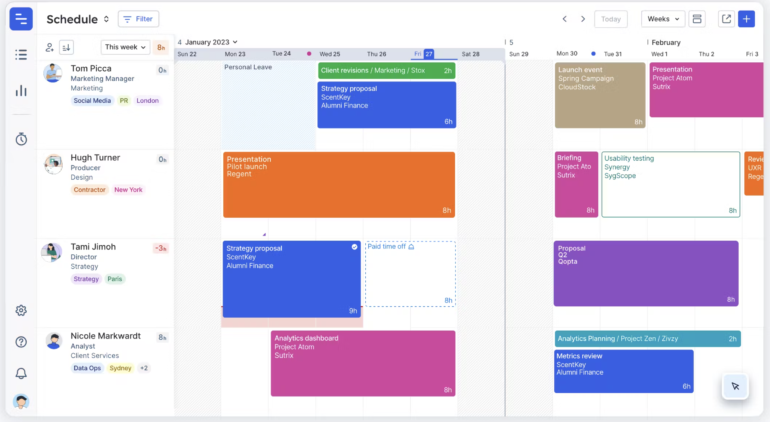
Float offers many tools that are helpful for agencies, specifically scheduling and time tracking tools. However, teams of all kinds will appreciate its workload allocation features and resource tracking tools, as well as its colorful, visual interface.
ClickUp is a cloud-based project management software that also includes resource management capabilities. You can quickly visualize digital company assets by using the list (Figure G), table or timeline view, or switch to the workload or box views to dig deeper into workload capacity. Time can be tracked via web browser or the desktop and mobile apps; you can also add manual entries and eset estimates for tasks. Collect vendor and pricing information to calculate costs, usage, downtime and other metrics.

ClickUp’s friendly, colorful interface belies its advanced project management and resource management tools. Its forever free plan will appeal to solopreneurs and small businesses, while its more expensive plans will satisfy enterprise needs.
For more information, read the full ClickUp review.
Resource Management is an add-on to Smartsheet’s core project management plans, and the software recently added workload tracking features to the Business and Enterprise plans as well. This cloud-based resource planning and scheduling tool helps organizations maximize their available resources and optimize their processes (Figure H). The software provides actionable insights on resource availability, task dependencies, resource capacity and performance, enabling managers to make better resource allocation decisions.
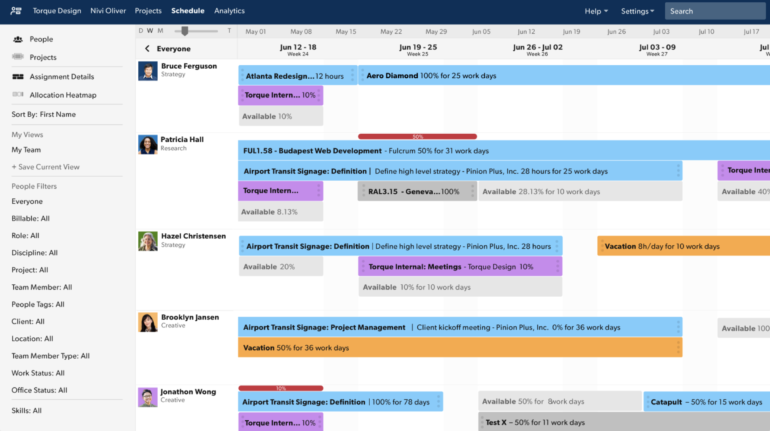
Smartsheet paired a traditional spreadsheet-style interface with complex project portfolio management and resource management apps. It offers workflows and automations, powerful analytics and excellent security features to keep your data safe.
For more information, read the full Smartsheet review.
Built for project managers, monday work management helps teams coordinate and collaborate on projects from start to finish. It offers numerous features to support resource planning, such as the ability to set different priority levels for different tasks (Figure I), creating time estimations before a project kicks off and re-allocating physical resources. Monday work management also comes with a dedicated workload view that lets you see which team members are over or under capacity at a glance.
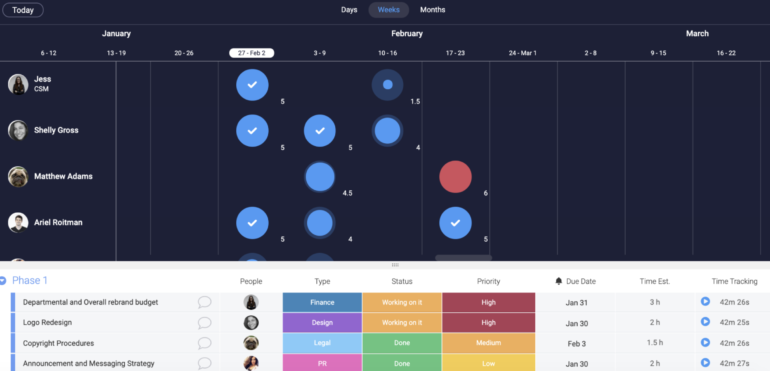
Monday work management is a very customizable and flexible platform, allowing you to tailor it to your resource planning software needs. It also offers five pricing plans to choose from, making it a highly scalable option that can grow with your business over time.
For more information, read the full monday.com review.
Wrike is a portfolio project management tool that includes resource management capabilities. With Wrike, you can manage team members, track availability and allocate available resources to tasks and projects. View your team’s workload and availability all on one page (Figure J), then use the drag-and-drop interface to manage resource planning and allocations. Users can also set priorities for tasks and projects to ensure that the most important work gets done first.
Figure J: The workload view in Wrike. Image: Wrike
Wrike’s advanced project portfolio management tool and resource planner software make it an excellent choice for medium and large enterprises. It also provides a forever free plan with limited features so that small businesses on a budget can still use it as well.
For more information, read the full Wrike review.
When shopping for your organization’s best resource management software, look for the following features:
Your chosen resource planner software should be able to allocate available resources to various projects or tasks based on their availability and skill sets. This can include managing staff, equipment and other resources.
The resource tracking software should be capable of planning and forecasting the capacity of resources, ensuring teams have enough resources to meet the demands of their projects.
The resource management app should allow teams to track planned time versus actual hours spent on tasks and resource usage. This can help managers identify areas where available resources could be better utilized.
The resource tracking tool should be able to automatically assign tasks to the right people and track progress to ensure tasks are completed on time.
The best resource management software should provide users with real-time data and analytics on resource utilization, project progress and other key performance indicators.
The best resource management software for your company depends on your needs and preferences. Start your search by defining your organization’s resource management needs. This includes the types of resources you need to manage, the level of complexity of your resource allocation process and any specific features or functionalities you require. Resource management involves handling sensitive data, so you should also prioritize project and resource management software with robust security features.
Next, research different resource management software options and compare their features, functionalities and pricing. Consider factors like ease of use, customization options and customer support when comparing resource forecasting tools to each other. Keep in mind that your resource management needs will likely change as your organization grows, so make sure that the pricing plans offer the scalability that you need in the future.
Once you have your short list of potential resource management apps, confirm that each platform is compatible with your existing systems and workflows and integrates well with your other tools. Request demos and trials of the resource planner software you’re considering to get a feel for its features, functionalities and user interface. This can help you make an informed decision before committing to a resource tracking tool.
We evaluated hundreds of available software solutions to determine the best resource management software in 2024. We looked at the features, pricing, customer reviews, ease of use, scalability and overall customer satisfaction. We also considered the opinions of industry leaders and customer feedback. We then identified the top-rated solutions and narrowed them down to the 10 best resource management software solutions.
24World Media does not take any responsibility of the information you see on this page. The content this page contains is from independent third-party content provider. If you have any concerns regarding the content, please free to write us here: contact@24worldmedia.com

5 Business Sectors Where Safety Glasses Are Essential

Annoying Things You Can Keep Out of Your Home

Easy Ways You Can Improve Your Pasture’s Quality

Mistakes You Must Avoid on Your Next Construction Project

Tips for Keeping Your Business’s Equipment Around for Longer

The Biggest Car Owner Mistakes You Must Avoid

Why Renting Construction Equipment Is Best

Beat the Heat: Summer Maintenance Tips for Forklifts

Monday’s stocks to buy include Apple, Nvidia, Tesla, Shopify and more

How to Tell If Your VPN Is Working Properly